|
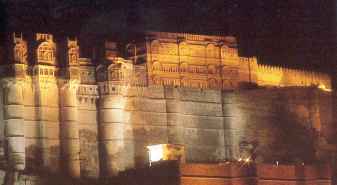 JODHPUR JODHPUR
Jodhpur was my last stop in Rajasthan. It is the second-largest city
in Rajasthan (after Jaipur). The Mehrangarh fort rises tall in the very
centre of the city, and is visible from various quarters. Jodhpur was once
the capital of the former princely state of Marwar, which means 'Land of
Death', probably, referring to the harsh desert climate. Founded in 1459
by Rao Jodha, the old quarter is surrounded by a 10km long 16th century
wall. with seven gates protecting the city.
A flourishing trading centre in the 16th century, Jodhpur is still one of
the leading centres of wood, cattle, camels and salt . Of all the places I
visited in Rajasthan, Jodhpur probably has the narrowest alleyways, with
2-way traffic, threading its way through a jumble of boisterous vegetable,
spice, textile, silver and handicraft bazaars. And yes, it was from here
that those baggy, tight horse-riding trousers (jodhpurs) took their
name, but you're unlikely to see anyone wearing them now.
Mehrangarh Fort
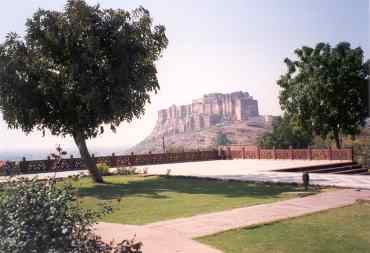 Mehrangarh
("Majestic Fort") rises majestically 400 feet above a rocky hill located
at the centre of the city. One of Rajasthan's three great hilltop forts
(the other two being Kumbhalgarh and Chittaurgarh), its awesome location,
massive gates, luxurious palaces and displays within them are awesome. The
views I saw from the fort parapets down onto the city below were that of a
sprawling city brightened by a number of homes, their walls washed in a
marine-blue paint, signifying they are the homes of Brahmins. Mehrangarh
("Majestic Fort") rises majestically 400 feet above a rocky hill located
at the centre of the city. One of Rajasthan's three great hilltop forts
(the other two being Kumbhalgarh and Chittaurgarh), its awesome location,
massive gates, luxurious palaces and displays within them are awesome. The
views I saw from the fort parapets down onto the city below were that of a
sprawling city brightened by a number of homes, their walls washed in a
marine-blue paint, signifying they are the homes of Brahmins.
There are, in all, three gates, each built to commemorate a particular
victory, as well as to reinforce the fort. Originally built in 1806, the
fort has been added to, many times since, and spreads over 5 kms. atop the
hill. The carved panels and porches, stained glass, elaborately adorned
walls and latticed windows of Moti Mahal, Phool Mahal, Sheesh Mahal, Sileh
Khana and Daulat Khana are worth seeing.
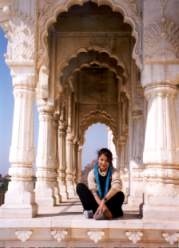 The
palaces in this fort have their own peculiar style, with narrow
staircases, serving as the only means of access to the royal rooms within.
A collection of well-preserved musical instruments, palanquins, cradles,
costumes, furniture and cannons on the fort's ramparts are on display. The
palaces in this fort have their own peculiar style, with narrow
staircases, serving as the only means of access to the royal rooms within.
A collection of well-preserved musical instruments, palanquins, cradles,
costumes, furniture and cannons on the fort's ramparts are on display.
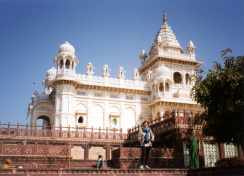 Employees
(sentries, guards & tourist guides) in the palace, dressed in traditional
Jodhpuri garb welcome you, and offer you information related to the
various rooms in the palaces, adding some folklore, legends, and royal
stories to their friendly dialogue. Employees
(sentries, guards & tourist guides) in the palace, dressed in traditional
Jodhpuri garb welcome you, and offer you information related to the
various rooms in the palaces, adding some folklore, legends, and royal
stories to their friendly dialogue.
Jaswant Thada
Close to Mehrangarh lies this white marble cenotaph, built in 1899, in
memory of Maharaja Jaswant Singh II. The building is made entirely of
marble, and the carvings on the arches, walls and temple roofs are very
beautiful. The inner room consists of rare portraits of various
rulers.
 Umaid
Bhavan Palace Umaid
Bhavan Palace
Said to be one of the largest private residences in the world, this 20th
century palace was built as a famine relief project, which gave employment
to the local people for 16 years. It is now a spacious and sumptuous hotel
run by ITC, though, a part of it has been retained as a museum (housing a
valuable collection of armoury & weaponry, cut-glass, clocks, paintings
etc.) and part as royal residence. Under an impressive dome, the Palace
houses over 300 rooms. It has its own theatre,
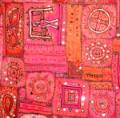 eight
dining rooms, and a banquet hall which seats three hundred people. Much of
the interior of the palace is in the art deco style, and is believed to
have one of the finest surviving examples of art deco in the world. eight
dining rooms, and a banquet hall which seats three hundred people. Much of
the interior of the palace is in the art deco style, and is believed to
have one of the finest surviving examples of art deco in the world.
Clock Tower and Sardar Market
A prime attraction of the city, is the Clock Tower and the colourful
Sardar Market near it. Narrow alleys lead to quaint bazaars selling fresh
vegetables, spices, textiles, antiques, silverware and handicrafts.
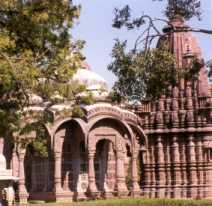 Mandore Mandore
This former capital of Marwar, lies 9 kms north of Jodhpur. The gardens of
Mandore also house the royal cenotaphs or 'dewals' of the Maharajas,
including Maharaja Jaswant Singh and, largest and finest of all, the
impressive temple-shaped memorial to Maharaja Ajit Singh. The Hall of
Heroes contains 15 figures carved out of a rock wall. The vividly painted
figures represent Hindu deities or local heroes on horseback. The Shrine
of 33 crore Gods, is painted with figures of gods, spirits and divinities.
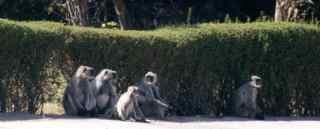 Monkeys
are a common sight in most parts of India. Clustered together in groups,
constantly bickering, snarling, and forgiving amicably all in an instant,
they didn't seem very unlike us humans in our social behavior! Don't get
too friendly with them though - they can normally be pretty mean if they
don't get what they want! Monkeys
are a common sight in most parts of India. Clustered together in groups,
constantly bickering, snarling, and forgiving amicably all in an instant,
they didn't seem very unlike us humans in our social behavior! Don't get
too friendly with them though - they can normally be pretty mean if they
don't get what they want! |
|
Recommendation for your Taste-Buds:
By the time I got to Jodhpur, I had had such a wonderful time gorging on
all the variety of food and desserts available, that I wasn't going to
spoil it all by heeding to reason and laying off all that rich delicious
stuff for a while. The tastiest food was to be had in the little roadside
restaurants and dhabas. I never suffered from any tummy disorders, mainly
due to the fact that I drank only bottled water, and ate food that was
'cooked'- no raw salads, or food that was sitting on shelves. Jodhpur had
many little "mithai" or sweet shops selling delicious whole milk and cream
preparations, and is known for its 'mawa kachori' - a rich crumbly
pastry stuffed with mawa and 'bade elaichi', makhaniya lassi (rich
frothy buttermilk), laddoos & peanut/jaggery chikki or brittle.
How to make your wallet lighter in Jodhpur:
There are a lot of fabric shops, selling 'bandhini' (very fine tie
& dye), hand block prints, silver shops selling jewelry by weight, and
antique shops.
Home :
Rajashthan :
Jaipur :
Jaisalmer :
Pushkar :
Jodhpur : Bombay :
Goa :
Rajashtani cuisine |